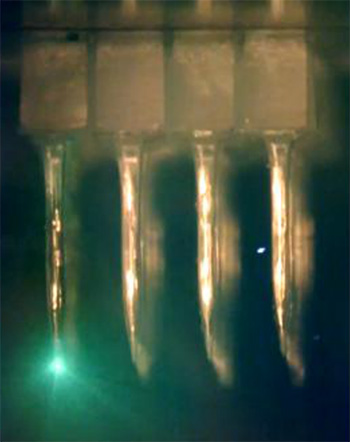
Spatiotemporal light delivery through the zinc oxide micro-optoelectrode array. Credit: Nat. Methods, doi: 10.1038/NMETH.3620
For the last 10 years, optogenetic technology has allowed researchers to probe the brain, one neuron at a time, to better understand how it works. However, linking neural activity to specific behaviors—which often involves a whole symphony of neurons—has proved difficult because existing electro-optical probes are not small enough or fast enough to capture the nearly simultaneous reaction to neural circuit activation.
Now, researchers from Brown University report having designed and demonstrated in rodent models an intracortical multifunctional microprobe array that can optically stimulate brain microcircuits while simultaneously recording the response (Nat. Methods, doi: 10.1038/NMETH.3620). The technology could someday lead to the development of neural prostheses, or, more broadly, serve as multipurpose bioengineering device sensor-and-actuator platforms.
Previous designs for multifunctional intracortical probes involved combining a light emitter block and an electronic sensor block into one bulky device. With these devices, the two material blocks are at least tens of micrometers apart, limiting their ability to simultaneously stimulate and sense neurons. Led by OSA Fellow Arto Nurmikko, the Brown researchers designed an integrated emission/sensing intracortical microprobe from an optically transparent, but highly conductive zinc oxide crystal. Zinc oxide’s transparency and wide bandgap allow it to deliver light and conduct electricity at the same time.
With colleagues from Seoul National University in Korea, Nurmikko’s team developed a microfabrication method to create the monolithic zinc oxide chip. The chip design includes an array of 16 micrometer-scale opto-electrodes that can each deliver light and sense electrical current. The array design enables the device to stimulate and record several nerve cells at once. They tested the micro-optoelectrode array’s performance with computational and mouse models. Benchtop tests of the device showed millisecond recording precision; and in mice, neural activity patterns were recorded at light-power levels ranging over three orders of magnitude.
Moving forward, the team would like to eventually incorporate wireless access to the device and see it used as a chronic (i.e., permanent) implant in humans.
